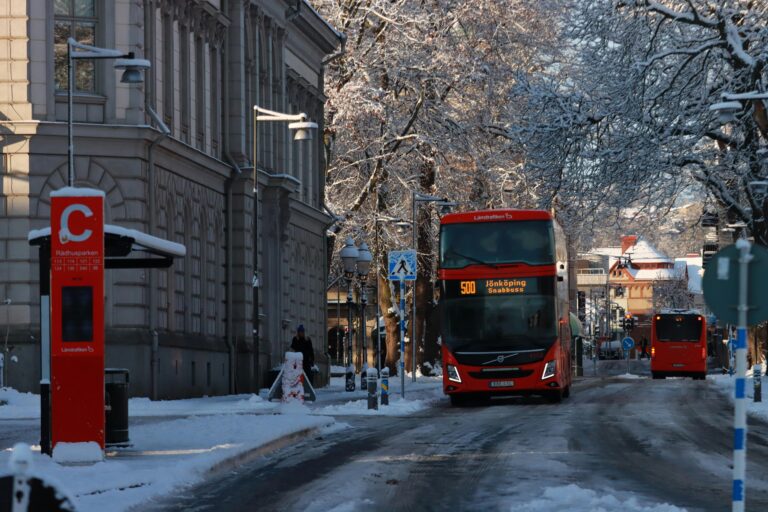Bildekreditt: Første student
New York City lanserer et av verdens største elektriske skolebussprogrammer. Byen planlegger å erstatte 45 000 dieselbusser i løpet av de kommende årene som en del av Veikart for elektriske skolebusser i staten New York (NYSERDA)Målet er å kutte utslipp, forbedre luftkvaliteten og gi elevene en roligere og sunnere skolevei.
For flåteoperatører og beslutningstakere tilbyr dette programmet verdifull lærdom om planlegging, infrastruktur og teknologi i stor skala.
Hvorfor skiftet er viktig
Skolebusser er sentrale for urban mobilitet, og i New York City bidrar de med en betydelig andel av de daglige transportutslippene. I følge Det amerikanske miljøvernbyrået, å erstatte én dieselbuss med en elektrisk ekvivalent kan redusere klimagassutslippene med opptil 54 tonn hvert år.
Hvis New York når målet om 45 000 elektriske busser, kan byen unngå mer enn 2,4 millioner tonn CO₂ årlig. Det er det samme som å ta mer enn 500 000 biler av veiene.
Helsefordelene er like viktige. Dieseleksos er knyttet til astma og luftveissykdommer som rammer barn uforholdsmessig hardt. Studier viser at elektriske skolebusser kan redusere eksponering for skadelige partikler med opptil 90 prosent inne i busskupeen. Harvard University-studie anslår at hver elektriske skolebuss gir opptil 14 207 000 pund i kombinerte helse- og klimafordeler i løpet av levetiden.
Stillere drift forbedrer også hverdagen i boligområder, reduserer støyforurensning og gir studentene en roligere start på dagen.
Utfordringene med å skalere til 45 000 busser
Én ting er å drive en liten elektrisk flåte. Å utvide til titusenvis av kjøretøy er en langt større utfordring. New Yorks skala introduserer et nytt sett med driftsmessige og tekniske hindringer:
Depotkapasitet: Koordinere lading for hundrevis av kjøretøy samtidig uten å overbelaste strømnettet.
Batterihåndtering: Forlenge batterilevetiden for å maksimere verdien over tid. Et erstatningsbatteri kan koste mer enn 30 000 euro per kjøretøy, så dårlig ladepraksis blir raskt dyrt.
Datasynlighet: Sporing av energiforbruk, ladeøkter og kjøretøyberedskap i sanntid.
Integrering: Sørge for at avgifts- og rutetabellsystemer fungerer sammen og er i samsvar med skolerutetabellene og byens transportvirksomhet.
Lærdommer fra Norden
Flere nordiske byer har allerede løst mange av disse utfordringene. Steder som Oslo og Stockholm bruker hundrevis av elektriske busser og har vist hva som skal til for å skalere.
Smart lading bidrar til å holde kostnadene under kontroll i ustabile energimarkeder. I Oslo rapporterer operatører energibesparelser på 20 til 30 prosent ved å flytte til perioder utenom rushtiden.
Depotstyringssystemer koordinere kjøretøyberedskap og strømnettets etterspørsel for å unngå overbelastning og sikre punktlige avganger.
Overvåking av batteritilstand forlenger batteriets levetid med tusenvis av sykluser og reduserer antall tidlige utskiftninger.
Interoperabilitet sørger for at busser og ladestasjoner fra forskjellige leverandører kan administreres gjennom ett sentralt system.
Disse fremgangsmåtene gjør det mulig for operatører å ekspandere med trygghet og opprettholde forutsigbar ytelse.
Hvordan Tenix støtter storskala utrullinger
Tenix leverer programvare for ladeoperasjoner utviklet i Norden og utprøvd i storskala flåtemiljøer. Plattformen hjelper operatører med å administrere komplekse elektrifiseringsprogrammer som New Yorks ved å samle all lade-, data- og driftsinnsikt i ett system.
Med Tenix kan operatører:
- Administrer depotlading på tvers av tusenvis av kjøretøy
- Optimaliser tidsplaner for å kutte energikostnadene med opptil 30 til 50 prosent
- Overvåk batteriets tilstand i sanntid for å forlenge levetiden til ressursene
- Integrer energi-, planleggings- og flåtedata i én plattform
For byer som skalerer raskt, er synlighet og automatisering nøkkelen. Tenix bidrar til å forenkle driften slik at elektrifiseringen kan vokse uten å øke kompleksiteten.
Ser fremover
Den neste fasen for New York vil fokusere på implementering. Tusenvis av busser må anskaffes, ladeknutepunkter må bygges på tvers av hundrevis av depoter, og energibehovet må balanseres med byens nettkapasitet. Koordinering mellom operatører, forsyningsselskaper og byetater vil være avgjørende.
Digitale verktøy vil spille en sentral rolle i å få dette til å fungere. Smarte ladesystemer, sanntidsdata og intelligent depothåndtering vil bidra til å holde kjøretøyene ladet effektivt og i rute.
New Yorks erfaringer vil ikke bare forbedre den lokale luftkvaliteten og folkehelsen. De vil sette en global standard for hvordan storbyer kan skalere nullutslippstransport. Med avansert planlegging, sterke partnerskap og teknologi fra leverandører som Tenix, kan overgangen til ren og pålitelig skoletransport gå fra pilotprosjekter til byomfattende realitet.




